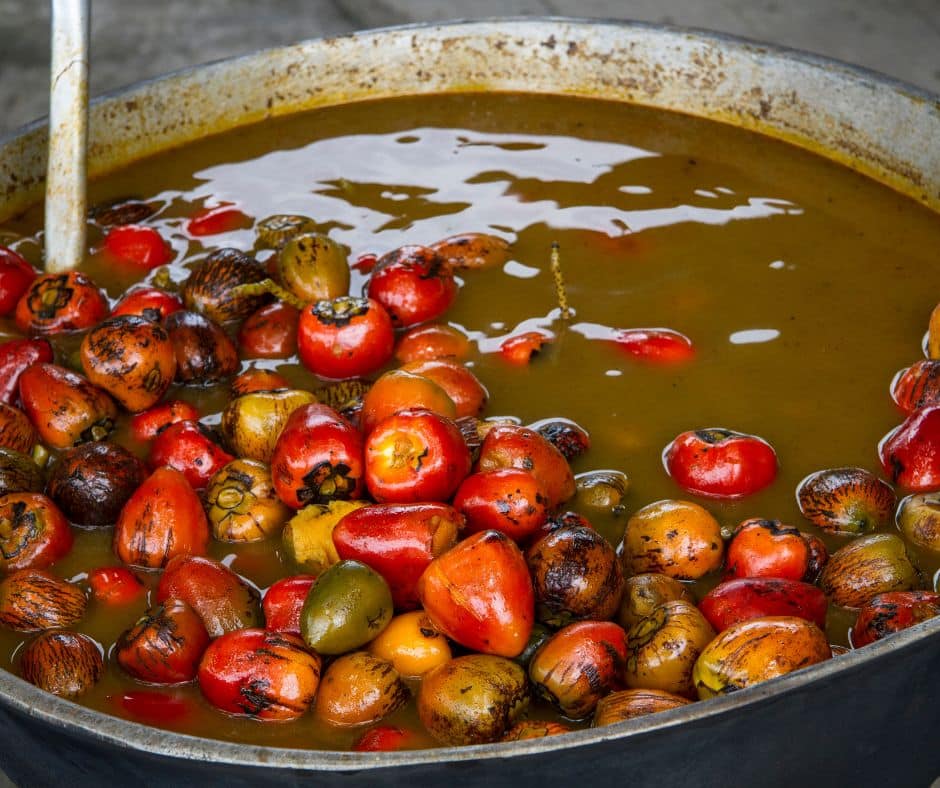Pejibaye, also known as peach palm fruit, is a staple in Costa Rica and much of Central and South America. This small, brightly colored fruit might not look like much at first glance, but it is packed with flavor, nutrients, and history. Whether you encounter it at a roadside stand, in a steaming bowl of soup, or even in a gourmet dish, pejibaye is a true culinary gem with a story to tell.
A Brief History of Pejibaye
The peach palm (Bactris gasipaes) has been cultivated for thousands of years by indigenous groups in the Amazon and throughout Central America. Used for both its fruit and its sturdy wood, the pejibaye tree became a valued resource for early civilizations. The fruit was not only a reliable food source but also played a role in social and cultural traditions. Over time, it became deeply rooted in Costa Rican cuisine, making its way into the everyday diet of Ticos, especially as a popular street food.
Health Benefits and Medicinal Properties
Pejibaye is often praised for its impressive nutritional profile. It is an excellent source of fiber, beta-carotene, vitamin C, vitamin A, calcium, and phosphorus, making it a powerhouse of essential nutrients. Some of its key health benefits include:
- Supports Eye Health: High in beta-carotene, pejibaye helps maintain good vision and promotes overall eye health.
- Boosts Immunity: With a good dose of vitamin C, it strengthens the immune system, helping the body fight off infections.
- Energy and Satiety: Pejibaye is rich in complex carbohydrates, providing a slow and steady release of energy, making it an ideal food for sustained energy throughout the day.
- Supports Digestion: The fiber content aids digestion and helps maintain gut health.
- Bone Strength: With calcium and phosphorus, it contributes to maintaining strong and healthy bones.
How to Eat Pejibaye
If you’ve ever had pejibaye raw, you probably found it to be dense, dry, and somewhat bitter—not the most appealing experience. That’s because pejibaye is almost never eaten raw. Instead, it is boiled or steamed, which transforms it into a soft, creamy, and slightly nutty treat.
One of the most traditional ways to eat pejibaye in Costa Rica is simply boiled, peeled, and enjoyed with a little mayonnaise or sour cream. The creamy texture of the condiment complements the slightly dry flesh of the fruit perfectly. It’s a common sight in homes and at street vendors, where people grab a quick, nutritious snack on the go.
How to Prepare Pejibaye
Preparing pejibaye at home is easy, but it does require some patience. Here’s a simple method:
Traditional Boiled Pejibaye
Ingredients:
- 10 pejibayes (peach palm fruits)
- Water
- 1 tbsp salt
- Optional: a bay leaf or two for extra flavor
Instructions:
- Rinse the pejibayes thoroughly to remove any dirt.
- In a large pot, bring water to a boil and add the pejibayes along with salt and optional bay leaves.
- Boil for 60 to 90 minutes until the flesh becomes soft. The longer they cook, the softer they get.
- Drain the water and let them cool slightly.
- Peel off the outer skin and remove the seed inside.
- Serve with a dollop of mayonnaise or enjoy as is!
Pejibaye in Modern Cuisine
Beyond the traditional boiled preparation, pejibaye has found its way into more refined culinary creations. It can be used to make purees, soups, and even bread and pancakes. One standout dish is Crema de Pejibaye, a delicious and velvety soup found in Costa Rican restaurants.
Pejibaye Cream Soup Recipe
Ingredients:
- 6 boiled pejibayes, peeled and deseeded
- 1 liter (4 cups) chicken or vegetable broth
- 1 cup heavy cream or coconut milk
- 1 small onion, chopped
- 2 cloves garlic, minced
- 1 tbsp butter or olive oil
- Salt and pepper to taste
Instructions:
- Heat the butter or oil in a pot and sauté the onion and garlic until fragrant.
- Add the boiled pejibaye and broth, then let simmer for 10 minutes.
- Blend the mixture until smooth.
- Return to the pot, add the cream or coconut milk, and season to taste.
- Heat through but do not boil. Serve warm with a drizzle of olive oil or croutons.
The Future of Pejibaye
Pejibaye remains an essential part of Costa Rica’s food culture, but its appeal is growing beyond local markets. With an increased interest in superfoods and sustainable eating, this nutrient-rich fruit is being recognized worldwide for its potential. Some innovative chefs are even incorporating it into gourmet menus, exploring its versatility beyond traditional methods.
So, next time you see pejibaye at a market or roadside stand, don’t hesitate to grab a few. Whether you enjoy it simply with mayonnaise or transform it into a creamy soup, this Costa Rican favorite is sure to delight your taste buds and nourish your body.






